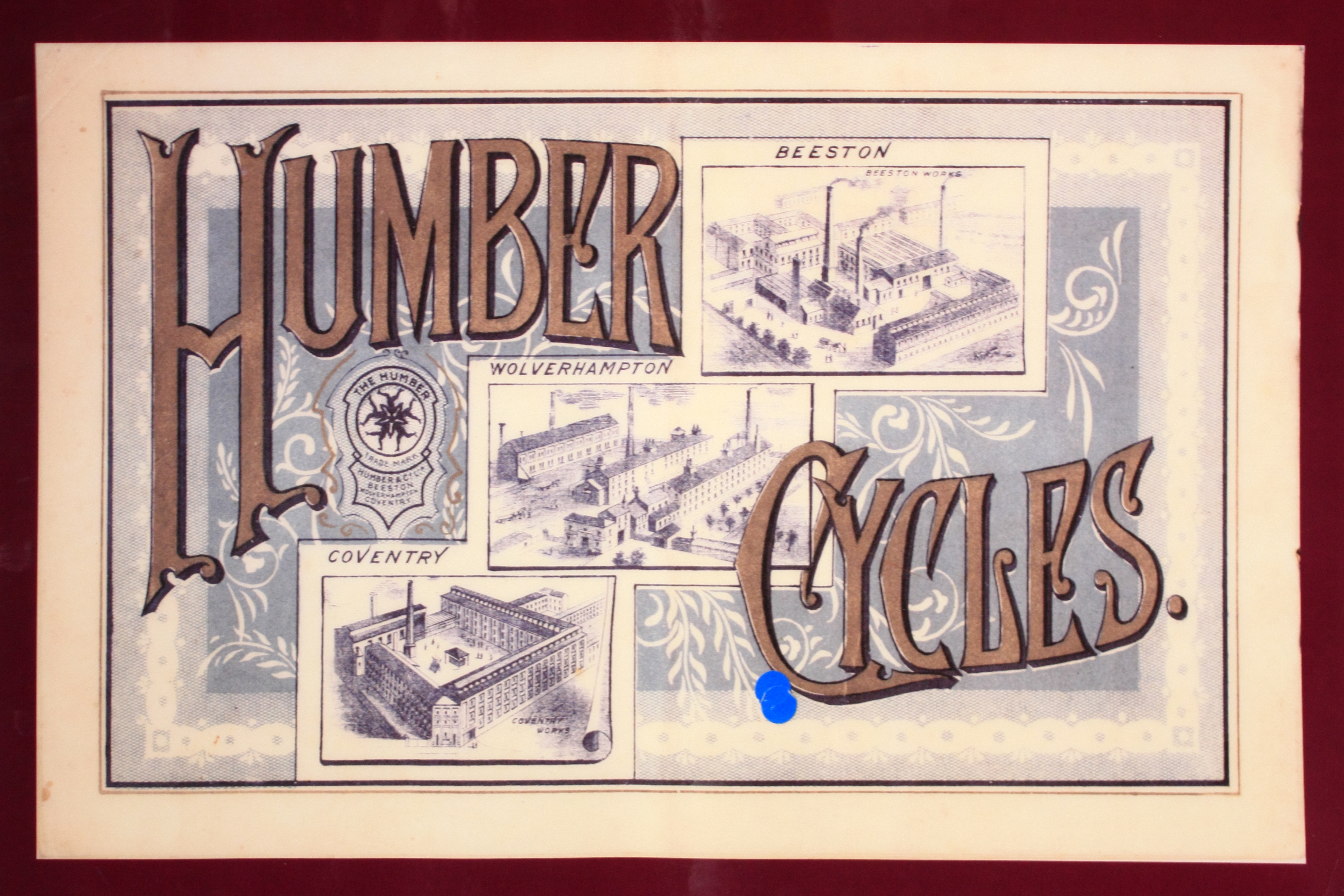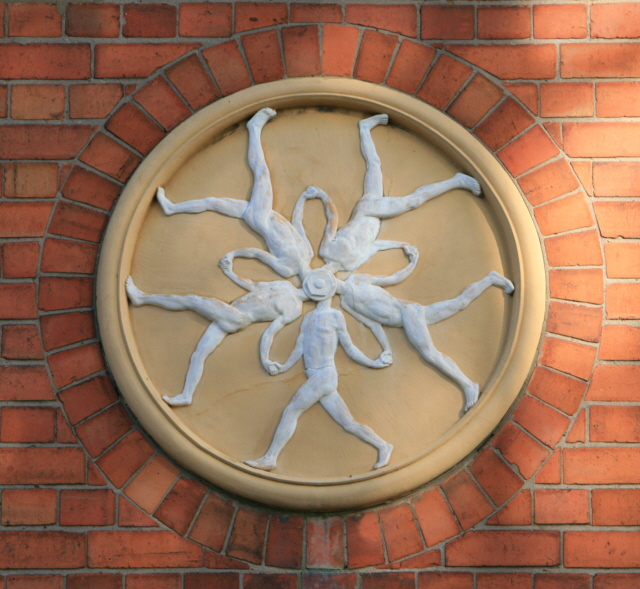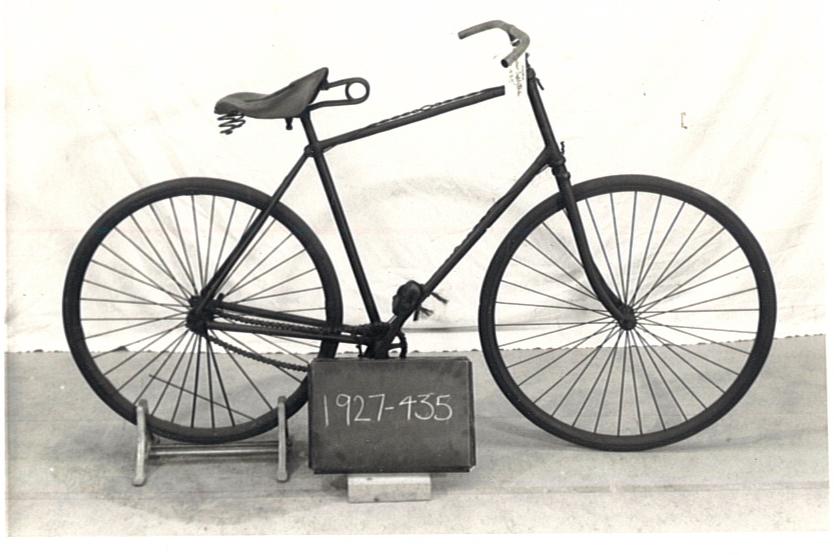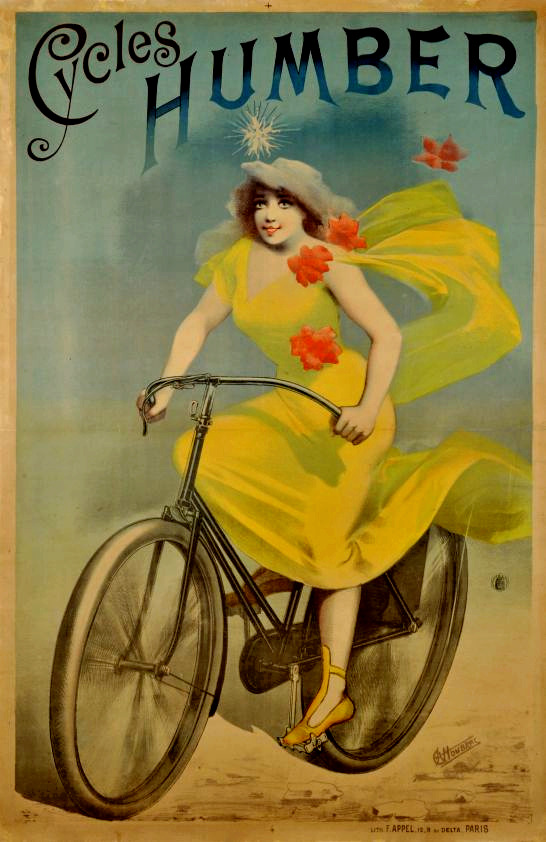Humber Cycles on:
[Wikipedia]
[Google]
[Amazon]

 Humber is an English brand of
Humber is an English brand of
 Thomas Humber (1841–1910)Paul Freund, 'Humber, Thomas (1841–1910)', ''Oxford Dictionary of National Biography'', Oxford University Press, May 2012 founded a bicycle manufacturing business at
Thomas Humber (1841–1910)Paul Freund, 'Humber, Thomas (1841–1910)', ''Oxford Dictionary of National Biography'', Oxford University Press, May 2012 founded a bicycle manufacturing business at

 Thomas's own design of " ordinary", now commonly known as a "penny-farthing", appeared in 1871 and not long after
Thomas's own design of " ordinary", now commonly known as a "penny-farthing", appeared in 1871 and not long after
 Cooper and Marriott left the firm in 1885 but Thomas let them have equal rights to the name Humber. He also let them use the old partnership's patents. They set themselves up as cycle wholesalers and later got Rudge of Coventry to make the cycles for them.
;Humber and Lambert
Thomas Humber took in a new partner, Nottingham lace bleacher dyer and finisher, T Harrison Lambert, and they took charge of the whole Humber business and its Beeston works. Lambert was a cycle-racing friend building a reputation as a successful company promoter.
;Humber & Company Limited, public listed company
The cycle industry was consolidating and Humber and Lambert soon sold the business to speculators: William and Joseph Horton, Edward Alfred Hicks and Christopher Norris Baker, who added a number of other substantial cycle manufacturers
* Thomas Humber and T Harrison Lambert trading as Humber & Co,
Cooper and Marriott left the firm in 1885 but Thomas let them have equal rights to the name Humber. He also let them use the old partnership's patents. They set themselves up as cycle wholesalers and later got Rudge of Coventry to make the cycles for them.
;Humber and Lambert
Thomas Humber took in a new partner, Nottingham lace bleacher dyer and finisher, T Harrison Lambert, and they took charge of the whole Humber business and its Beeston works. Lambert was a cycle-racing friend building a reputation as a successful company promoter.
;Humber & Company Limited, public listed company
The cycle industry was consolidating and Humber and Lambert soon sold the business to speculators: William and Joseph Horton, Edward Alfred Hicks and Christopher Norris Baker, who added a number of other substantial cycle manufacturers
* Thomas Humber and T Harrison Lambert trading as Humber & Co, 
 Thomas Humber agreed to manage the whole enterprise with its works in Coventry and Wolverhampton as well as Beeston. Aged 51, Thomas Humber retired in 1892 at the end of his 5-year contract.
;Humber and Company (America) Limited, Humber and Company (France) Limited, Humber and Company (Extension) Limited etc.
A period of strong overseas expansion began in 1894 followed by an administrative separation of manufacturing from wholesaling and retailing. An 1896 joint venture with major French cycle companies, Clement and
Thomas Humber agreed to manage the whole enterprise with its works in Coventry and Wolverhampton as well as Beeston. Aged 51, Thomas Humber retired in 1892 at the end of his 5-year contract.
;Humber and Company (America) Limited, Humber and Company (France) Limited, Humber and Company (Extension) Limited etc.
A period of strong overseas expansion began in 1894 followed by an administrative separation of manufacturing from wholesaling and retailing. An 1896 joint venture with major French cycle companies, Clement and 
 In 1896 Humber produced the first practical motorcycle by fitting a bicycle with an E. J. Pennington two-horsepower motor.
In 1896 Humber produced the first practical motorcycle by fitting a bicycle with an E. J. Pennington two-horsepower motor.
File:Humber Penny Farthing head tube Coventry Transport Museum.jpg, Badge on a Beeston

 Humber is an English brand of
Humber is an English brand of bicycle
A bicycle, also called a pedal cycle, bike or cycle, is a human-powered or motor-powered assisted, pedal-driven, single-track vehicle, having two wheels attached to a frame, one behind the other. A is called a cyclist, or bicyclist.
B ...
. Thomas Humber made himself a velocipede in 1868. From that time he built a substantial business in manufacturing tricycles and bicycles while continuously improving their design and construction. His products were so well-made and well-designed they were known as "the aristocrat among bicycles".
Though Thomas Humber retired from the cycle business in 1892 and went on to other things his brand name remained a high valued trademark for more than ninety years.
__TOC__
History
 Thomas Humber (1841–1910)Paul Freund, 'Humber, Thomas (1841–1910)', ''Oxford Dictionary of National Biography'', Oxford University Press, May 2012 founded a bicycle manufacturing business at
Thomas Humber (1841–1910)Paul Freund, 'Humber, Thomas (1841–1910)', ''Oxford Dictionary of National Biography'', Oxford University Press, May 2012 founded a bicycle manufacturing business at Nottingham
Nottingham ( , locally ) is a city and unitary authority area in Nottinghamshire, East Midlands, England. It is located north-west of London, south-east of Sheffield and north-east of Birmingham. Nottingham has links to the legend of Robi ...
which moved about 1878 to Beeston, Nottinghamshire
Beeston is a town in the Borough of Broxtowe, Nottinghamshire, England, south-west of Nottingham city centre. To its north-east is the University of Nottingham's main campus, University Park. The pharmaceutical and retail chemist group Boot ...
. By 1887, still under his day-to-day management, it was owned by a public listed company, Humber & Co Limited. Thomas Humber improved cycle technology through the independence of his thinking and his practical ability. The reliability of his products arose from his high standards and emphasis on quality. It all led to Humber becoming regarded as the aristocrat among bicycles.
;Velocipede
Thomas Humber, at that time by trade a Nottingham blacksmith
A blacksmith is a metalsmith who creates objects primarily from wrought iron or steel, but sometimes from other metals, by forging the metal, using tools to hammer, bend, and cut (cf. tinsmith). Blacksmiths produce objects such as gates, gr ...
, had built himself a velocipede
A velocipede () is a human-powered land vehicle with one or more wheels. The most common type of velocipede today is the bicycle.
The term was probably first coined by Karl von Drais in French as ''vélocipède'' for the French translation ...
based on a picture in a letter about the Paris-developed machine that was published in the ''English Mechanic'' magazine in late 1868. He sold it and made an improved version—bought by the same buyer. It took him 2 months to make each velocipede, he was concerned to develop improvements: solid rubber tyres, ball-bearings, while maintaining quality and reliability. He instituted races to win public interest.
Ordinary or "Penny-farthing"

 Thomas's own design of " ordinary", now commonly known as a "penny-farthing", appeared in 1871 and not long after
Thomas's own design of " ordinary", now commonly known as a "penny-farthing", appeared in 1871 and not long after James Starley
James Starley (21 April 1830 – 17 June 1881) was an English inventor and father of the bicycle industry. He was one of the most innovative and successful builders of bicycles and tricycles. His inventions include the differential gear and t ...
's metal ordinary. His first price-list contained a testimonial by Fred Cooper, a racing cyclist. Another racing contact was Thomas Marriott.
Safety bicycle
Thomas Humber developed and patented thesafety bicycle
A safety bicycle (or simply a safety) is a type of bicycle that became very popular beginning in the late 1880s as an alternative to the penny-farthing ("ordinary") and is now the most common type of bicycle. Early bicycles of this style were know ...
(1884) with a diamond-shaped frame and wheels of similar size.
Ownership
;Humber, Marriott and Cooper Thomas Marriott joined Thomas Humber as a business partner in 1875 and Fred Cooper joined them two years later. They named their new firm Humber, Marriott & Cooper. Their staff of 80 or so needed more factory space so they built them a new works at Beeston. Cooper and Marriott left the firm in 1885 but Thomas let them have equal rights to the name Humber. He also let them use the old partnership's patents. They set themselves up as cycle wholesalers and later got Rudge of Coventry to make the cycles for them.
;Humber and Lambert
Thomas Humber took in a new partner, Nottingham lace bleacher dyer and finisher, T Harrison Lambert, and they took charge of the whole Humber business and its Beeston works. Lambert was a cycle-racing friend building a reputation as a successful company promoter.
;Humber & Company Limited, public listed company
The cycle industry was consolidating and Humber and Lambert soon sold the business to speculators: William and Joseph Horton, Edward Alfred Hicks and Christopher Norris Baker, who added a number of other substantial cycle manufacturers
* Thomas Humber and T Harrison Lambert trading as Humber & Co,
Cooper and Marriott left the firm in 1885 but Thomas let them have equal rights to the name Humber. He also let them use the old partnership's patents. They set themselves up as cycle wholesalers and later got Rudge of Coventry to make the cycles for them.
;Humber and Lambert
Thomas Humber took in a new partner, Nottingham lace bleacher dyer and finisher, T Harrison Lambert, and they took charge of the whole Humber business and its Beeston works. Lambert was a cycle-racing friend building a reputation as a successful company promoter.
;Humber & Company Limited, public listed company
The cycle industry was consolidating and Humber and Lambert soon sold the business to speculators: William and Joseph Horton, Edward Alfred Hicks and Christopher Norris Baker, who added a number of other substantial cycle manufacturers
* Thomas Humber and T Harrison Lambert trading as Humber & Co, Beeston, Nottingham
Beeston is a town in the Borough of Broxtowe, Nottinghamshire, England, south-west of Nottingham city centre. To its north-east is the University of Nottingham's main campus, University Park. The pharmaceutical and retail chemist group Boots h ...
, 350 men*, established 1868 also in London
London is the capital and List of urban areas in the United Kingdom, largest city of England and the United Kingdom, with a population of just under 9 million. It stands on the River Thames in south-east England at the head of a estuary dow ...
* Coventry Cycle Company Limited, Whitefriars Lane Coventry
Coventry ( or ) is a city in the West Midlands, England. It is on the River Sherbourne. Coventry has been a large settlement for centuries, although it was not founded and given its city status until the Middle Ages. The city is governed b ...
, 160 men, established 1871
* Joseph Devey's Express Cycle Works, Wolverhampton
Wolverhampton () is a city, metropolitan borough and administrative centre in the West Midlands, England. The population size has increased by 5.7%, from around 249,500 in 2011 to 263,700 in 2021. People from the city are called "Wulfrunians ...
, 170 men, established 1873
* George Townend's Wellington Works, Coventry, which held "a practical monopoly" of machines for juveniles
: Details such as production quantities were audited by London chartered accountant John R Ellerman
: * Humber alone made all the components for its machines instead of buying them
" (Humber & Co Limited) . . . at once becomes the most powerful combination in this growing and lucrative industry." and then floated the new combine on the stock exchange.Public Companies. ''The Times'', Saturday, 18 June 1887; pg. 4; Issue 32102 Such was the public's recognition of Humber products and their high quality and reliability the whole new organisation was named Humber & Co Limited though Humber's was not the largest component.
;Production, deliveries and order book just before combination

 Thomas Humber agreed to manage the whole enterprise with its works in Coventry and Wolverhampton as well as Beeston. Aged 51, Thomas Humber retired in 1892 at the end of his 5-year contract.
;Humber and Company (America) Limited, Humber and Company (France) Limited, Humber and Company (Extension) Limited etc.
A period of strong overseas expansion began in 1894 followed by an administrative separation of manufacturing from wholesaling and retailing. An 1896 joint venture with major French cycle companies, Clement and
Thomas Humber agreed to manage the whole enterprise with its works in Coventry and Wolverhampton as well as Beeston. Aged 51, Thomas Humber retired in 1892 at the end of his 5-year contract.
;Humber and Company (America) Limited, Humber and Company (France) Limited, Humber and Company (Extension) Limited etc.
A period of strong overseas expansion began in 1894 followed by an administrative separation of manufacturing from wholesaling and retailing. An 1896 joint venture with major French cycle companies, Clement and Gladiator
A gladiator ( la, gladiator, "swordsman", from , "sword") was an armed combatant who entertained audiences in the Roman Republic and Roman Empire in violent confrontations with other gladiators, wild animals, and condemned criminals. Some gla ...
failed.
There was a cycling boom over 1895-97 —see the enthusiastic move into France— as pneumatic tyres attracted a new class of riders but it was followed by a slump over 1898-99.
;Humber Limited
Following these financial difficulties in 1899 Humber & Co Limited's business was transferred to a new incorporation named Humber Limited
Humber Limited was a British manufacturer of bicycles, motorcycles, and cars incorporated and listed on the stock exchange in 1887. It took the name "Humber & Co Limited" because of the high reputation of the products of one of the constituen ...
.
;Raleigh
Raleigh (; ) is the capital city of the state of North Carolina and the seat of Wake County in the United States. It is the second-most populous city in North Carolina, after Charlotte. Raleigh is the tenth-most populous city in the Southeas ...
By 1914 Humber had become Britain's second largest motorcar manufacturer and cycles became less important. In February 1932 renewed financial difficulties in part due to the Great Depression
The Great Depression (19291939) was an economic shock that impacted most countries across the world. It was a period of economic depression that became evident after a major fall in stock prices in the United States. The economic contagio ...
and a brief surge in cycle sales saw Humber's cycle trademarks and patents sold to Raleigh. Humber continued as a premium brand made by Raleigh into the 1960s.

Frame
Humber also manufactured, at one time, an unusual type ofbicycle frame
A bicycle frame is the main component of a bicycle, onto which wheels and other components are fitted. The modern and most common frame design for an upright bicycle is based on the safety bicycle, and consists of two triangles: a main triangl ...
known variously as "cross frames", "girder frames", or "truss frames". Their variant was also duplex, consisting in part of smaller side-by-side tubes similar to the duplex fork pictured on this page.
Motorcycles
 In 1896 Humber produced the first practical motorcycle by fitting a bicycle with an E. J. Pennington two-horsepower motor.
In 1896 Humber produced the first practical motorcycle by fitting a bicycle with an E. J. Pennington two-horsepower motor.
Gallery
penny farthing
The penny-farthing, also known as a high wheel, high wheeler or ordinary, is an early type of bicycle. It was popular in the 1870s and 1880s, with its large front wheel providing high speeds (owing to its travelling a large distance for every r ...
Image:Humber head badge.JPG, Badge
A badge is a device or accessory, often containing the insignia of an organization, which is presented or displayed to indicate some feat of service, a special accomplishment, a symbol of authority granted by taking an oath (e.g., police and ...
Humber Limited and royal warrant
File:Humber-Raleigh Headtube (4542136807).jpg, Badge Humber by Raleigh
Image:Humber Sport.JPG, Humber sports Sturmey Archer 3-speed
Image:Humber fork.JPG, Humber sports duplex forks
File:Btv1b8433329b-p089.jpg, Henri Loste, Champion du Midi, on a Humber bicycle with a Simpson lever chain c. 1894
See also
* Humber Motorcycles *Humber Limited
Humber Limited was a British manufacturer of bicycles, motorcycles, and cars incorporated and listed on the stock exchange in 1887. It took the name "Humber & Co Limited" because of the high reputation of the products of one of the constituen ...
* Thomas Humber
* List of bicycle manufacturing companies
This page lists notable bicycle brands and manufacturing companies past and present. For bicycle parts, see List of bicycle part manufacturing companies.
Many bicycle brands do not manufacture their own product, but rather import and re-brand ...
* Raleigh Cycles - Biggest UK manufacture at one period.
Note
References
{{British bicycle manufacturers Defunct cycle manufacturers of the United Kingdom Companies based in Nottinghamshire